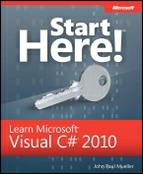Book Description
Ready to learn programming? Start Here!
Learn the fundamentals of modern programming with Visual C# 2010—and begin building your first apps for the desktop and web. If you have absolutely no previous experience, no problem—simply start here! This book introduces must-know concepts and techniques through easy-to-follow explanations, examples, and exercises.
Here’s where you start learning Visual C#
Learn how an application performs tasks by tracing its code
Query and manipulate application data with LINQ
Access web services with REST and SOAP
Build simple apps with Windows Presentation Foundation
Explore rich Internet apps with Microsoft Silverlight
Find and fix errors by debugging your applications
Put it all together by creating your first programs
Table of Contents
- Start Here!™: Learn Microsoft® Visual C#® 2010
- Dedication
- A Note Regarding Supplemental Files
- Introduction
- 1. Getting to Know C#
- 2. Developing a Web Project
- 3. Basic Data Manipulation Techniques
- Understanding LINQ
- Creating the List Project
- Using the Code Editor
- Testing the List Application
- Tracing the List Application with the Debugger
- Creating the List 2 Project
- Get Going with C#
- 4. Using Collections to Store Data
- 5. Working with XML
- 6. Accessing a Web Service
- Defining Web Services
- Web Services and XML
- Working with REST Web Services
- Working with SOAP Web Services
- Developing the REST Web Service Application
- Developing the SOAP Web Service Application
- Get Going with C#
- 7. Using the Windows Presentation Foundation
- Considering the WPF Differences with Windows Forms Applications
- Understanding XAML
- Developing the WPF Data Store Application
- Developing the WPF SOAP Web Service Application
- Developing the EmbeddedSource Application
- Get Going with C#
- 8. Working with Libraries
- Understanding Reusable Code
- Considering How Classes Work
- Creating the UseLibrary Solution
- Adding the TestApplication Project
- Testing the UseLibrary Application
- Get Going with C#
- 9. Creating Utility Applications
- 10. Using LINQ in Web Applications
- 11. Working with Silverlight Applications
- Understanding the Silverlight Development Difference
- Developing a Basic Silverlight Application
- Configuring Your Silverlight Application for Debugging
- Adding XML Data Support to a Silverlight Application
- Get Going with C#
- 12. Debugging Applications
- Index
- About the Author
- Copyright
